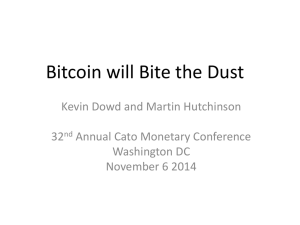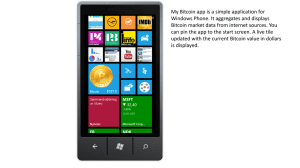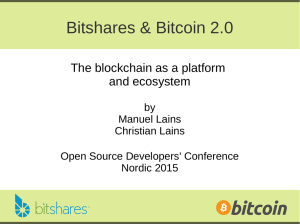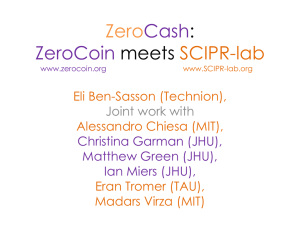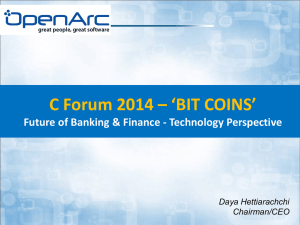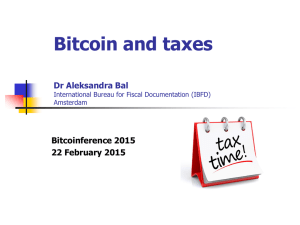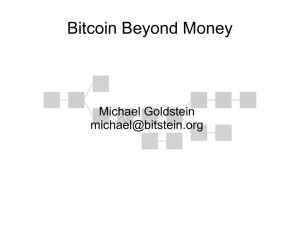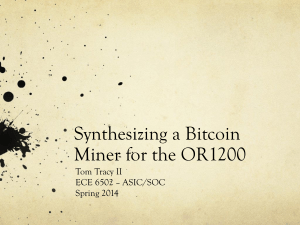powerpoint
advertisement
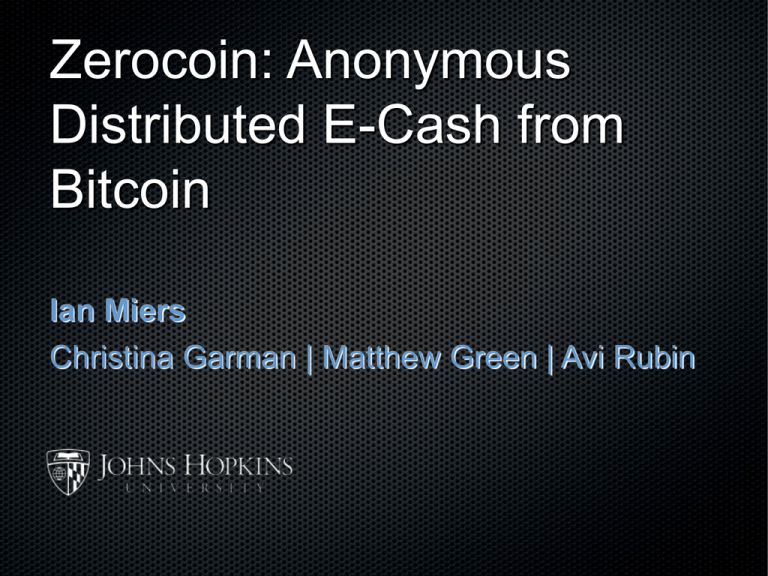
Zerocoin: Anonymous Distributed E-Cash from Bitcoin Ian Miers Christina Garman | Matthew Green | Avi Rubin Digitizing money Two ways to do it Create digital cash Create digital checks Bank accounts Problem: privacy Bank sees every transaction Merchants can track customers across interactions Digital cash Can’t make uncopyable digital currency Can make single use currency Get a unique serial number when you withdraw money Spend it by showing an unused serial number E-cash Chaum82: blind signatures for e-cash Chaum88: retroactive double spender identification Brandis95: restricted blind signatures Camenisch05: compact offline e-cash An ideal digital currency Decentralized Bitcoin A distributed digital currency system Released by Satoshi Nakamoto 2008 Market cap of 1.2 Billion USD (as of early May 2013) Effectively a bank run by an ad hoc network Digital checks A distributed transaction log Bitcoin: digital checks Public key 0xc7b2f68... Public key 0xa8fc93875a972ea Signature 0xa87g14632d452cd Bitcoin: transaction log How do you maintain a transaction log? Pick a trusted party Vote Avoiding the clone wars Select a node at random proportional to its computational power to update the log Nodes race to compute a partial hash collision: hash(data || nonce) < x Pick the longest chain Bitcoin calls this ledger the block chain Bitcoin Decentralized Bitcoin Decentralized Bitcoin Decentralized Bitcoin Decentralized Bitcoin: all of your information is known to the bank the merchants EVERYONE Chaum’s e-cash + Bitcoin Decentralized Bitcoin laundries & mixes Decentralized Zerocoin A distributed approach to private electronic cash Extends Bitcoin by adding an anonymous currency on top of it Zerocoins are exchangeable for bitcoins Similar to techniques by Sander and Ta-shma What is a zerocoin? A zerocoin is: Economically: a promissory note redeemable for a bitcoin Cryptographically: an opaque envelope containing a serial number used to prevent double spending 823848273471 012983 Commitments 812... Allow you to commit to and later reveal a value Binding: value cannot be tampered with Blinding: value cannot be read until revealed We use Pedersen commitments 812.. Zerocoins: where do they come from? Anyone can make one Choose a random serial number and commit to it Mint a zerocoin by putting a mint transaction in the block chain which “spends” a bitcoin and includes the commitment Spending a zerocoin gives the recipient a bitcoin Zerocoins: ...and where do they go? The “spent” bitcoins end up escrowed To spend a zerocoin You reveal the serial number Prove it is from some zerocoin in the block chain Put the spent serial number in the block chain Zero-knowledge proofs Zero-knowledge [Goldwasser, Micali 1980s, and beyond] Prove knowledge of a witness satisfying a statement Specific variant: non-interactive proof of knowledge Here we prove we know: 1. The serial number of a zerocoin 2. That the coin is in the block chain An inefficient approach Inefficient proof Identify all valid zerocoins in the block chain (call them ) Prove that S is the serial number of a coin C and This “OR” proof is O(N) Cryptographic accumulators Allow constant size set membership proofs Strong RSA accumulator originally due to Benaloh and de Mare Efficient proof for accumulation of primes proposed by Camenisch and Lysyanskaya ‘01 Zerocoin protocol Generate a commitment to a random serial number S: where is prime (Store serial number S and randomness r) Accumulate all valid coins, compute witness wi Reveal S and prove knowledge of witness to commitment accumulation and its randomness r Performance Modified bitcoind client on 3.5GZ Intel Xeon E31270V2 1024 bit commitments 1024, 2048, and 3072 bit RSA moduli Obstacles and future work Scale to larger networks Reduce proof size (duh) Make divisible coins (we have a construction) Get people to believe this works Zerocoin.org Decentralized Ian Miers @imichaelmiers Christina Garman Matthew Green Avi Rubin Divisible coins (Not in paper) Encode both a serial number and a denomination in the coin commitment as the low and high order bits To divide a coin C with balance b and serial number S Mint two new coins c’,c’’ with balances b’ and b’’ Prove in zero knowledge that b = b’ + b’’ and those are the high order bits Reveal S to prevent reuse Prime commitments Perfectly Blinding • Binding under discrete log How much anonymity Consider a universe where 10 coins exist and one more coin is minted and then spent If all 10 original coins are already spent before minting, k =1 If only 9 of them are spent, k = 11 Lower bound: All unspent coins controlled by honest parties Upper bound: All the coins Why so large? Laptop performance Not much slower (our code is single threaded) In UFOs we trust RSA moduli of Unknown FactOrization (Sander99) N is an RSA-UFO if it has at least two large prime factors P and Q and no one can find N1,N2 such that Q divides N1 and P divides N2 Get an assumption analogous to the Strong RSA assumption UFOs: Impractically Large Problem: for the security of a 1024 bit RSA modulus, we need a 40k bit UFO
